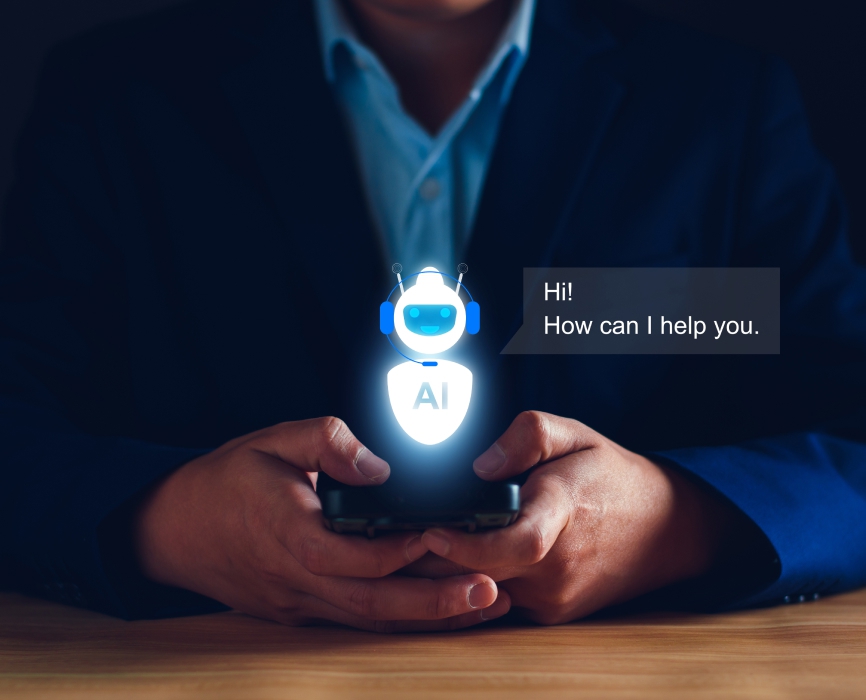
An introduction to AI
What is Ai?
FACT 1
AI stands for artificial intelligence.
The term refers to “intelligent agents capable of performing tasks that would typically require human levels of intelligence”, such as solving problems, making decisions, and recognising human speech.
FACT 2
It was invented in 1957.
Allen Newell, Cliff Shaw, and Herbert Simon created their Logic Theorist program, believed to be the first AI program. However, the concept of AI had been in the works for many years previously, most notably when Alan Turing authored a paper entitled ‘Computing Machinery and Intelligence’. He proposed that humans are able to use the information they have available to make decisions and solve problems, so machines could do the same.

Alan Turing proposed that machines could use available information to make decisions and solve problems.
FACT 3
However, AI doesn’t understand text and data the way humans do; it can simply process the patterns it sees.
FACT 4
AI may follow a specific set of conditions (narrow AI), or it may use machine learning to adapt its approach.
a) An example of rule-based or narrow AI:
Email filters, which sort incoming emails into categories according to a defined set of conditions. This can be particularly useful for identifying and deleting spam emails.
b) An example of machine learning AI:
Online product recommendations, where the recommendations are generated by grouping customers together based on shared characteristics (like their demographic or buying habits) and predicting what one customer will want based on another customer’s activity.
FACT 5
Machine learning has existed for longer than we might realise.
The foundations were laid throughout the 1700s, 1800s, and early 1900s, when classical statistical techniques for small data sets were developed. Basic techniques for machine learning were developed throughout the 1930s and 1940s, and the aforementioned Logic Theorist program was created in the 1950s. But it wasn’t until the 1970s that computers were capable of running machine learning programs.

The Logic Theorist program was created in the 1950s
What can AI do for us?
FACT 6
AI is important because of the opportunities it presents for innovation.
For example, existing products can be enhanced using AI — think of Apple adding Siri to their devices.
FACT 7
Recently, generative AI has made the headlines.
Generative AI is a type of machine learning AI by which algorithms are used to create content, including written work, images, audio and code. The most well-known generative AI is the chatbot ChatGPT.
FACT 8
But AI can be used for more than content creation.
It adds to numerous technologies in our homes and in the workplace, from security systems that learn your normal behaviours and detect unusual activity, to algorithms that enhance medical imaging and lead to earlier detection, diagnosis and treatment. It also adds more to the customer service experience.
FACT 9
It’s a common misconception that AI will replace all human jobs.
While AI can perform repetitive tasks quickly, reliably, and without getting tired, it cannot replicate the human skills needed for many jobs, such as critical thinking, sound judgement, creativity and emotional intelligence. Humans are also needed to set AI systems up and provide the necessary information and questions — AI cannot think for itself and doesn’t understand information it’s given.

While AI can perform repetitive tasks quickly, reliably, and without getting tired, it cannot replicate the human skills needed for many jobs
What will happen to customer service jobs?
Job security
FACT 10
Although AI is a relatively new addition to customer service, it’s naturally caused concern amongst workers, who worry about job security.
FACT 11
AI has the potential to replace 10-30% of the jobs in the UK, according to a report by the Department of Education.
FACT 12
However, experts predict that the nature of customer service jobs will change, rather than being completely replaced.
FACT 13
It’s important to note that AI is only as powerful as the information it’s given — it’s not helpful if it’s not used correctly, and humans are still needed in complex situations.

It’s important to note that AI is only as powerful as the information it’s given — it’s not helpful if it’s not used correctly
The benefits of AI in customer service
FACT 14
Tedious tasks, such as refunding payments, can be automated using AI.
This leads to greater productivity and efficiency, leaving employees with time to focus on complex, more engaging tasks, such as:
Identifying ways the customer service experience can be improved and why these improvements need to be made
Ensuring the AI interactions with customers are meeting their needs
Ensuring the AI interactions with customers are ethical
Testing proposed new additions to the AI system’s capabilities
Ensuring data privacy
Identifying and eliminating data bias
FACT 15
Not only could this lead to greater efficiency for customers, but it could also benefit both business owners and people working in customer service.
Turnover rates are traditionally high in customer service roles. For example, annual turnover rates for call centres are between 30% and 45%, which means companies have to spend time and money recruiting and training new employees. The customer experience is also impacted as the fresh recruits get to grips with the nature of the job.

Turnover rates are traditionally high in customer service roles
FACT 16
The turnover rates are lower for service organisations as a whole, at 19%.
FACT 17
By improving the day-to-day responsibilities of customer service jobs, companies can create greater job satisfaction and reduce the turnover rate.
This improves the customer experience, as people are more likely to have an interaction that successfully resolves their query.
FACT 18
Another way to create greater job satisfaction amongst customer service employees is to improve the culture of your business.
You can do this by:
Creating a shared purpose and values for everyone across the company to put into practice. While people may have different roles and responsibilities, identifying what’s meaningful to them and enabling them to work towards it can boost motivation and morale. In a customer service role, a clear shared purpose would be to help people solve their problems quickly and efficiently.
Looking at the benefits you have on offer. The pandemic led to a shift in workers’ priorities and people are more likely to look for flexibility and understanding from their employers. This can have a positive impact on everyone: research by Ernst and Young shows that 87% of workers feel that mutual empathy between them and their bosses increases their efficiency and creativity.
Employees in customer service roles will need to work during hours where there’s peak demand for help, but that doesn’t mtean businesses can’t offer flexibility or benefits in other ways. Whether it’s offering remote or hybrid working so people don’t need to spend time and money commuting, or introducing a bonus scheme for employees who achieve beyond their targets, there are ways to show trust and appreciation.
Spending time on the onboarding process. It can be tempting to get your new recruits working nearly straight away, especially if you’re short on numbers, but having a thorough onboarding process and training in place can increase your employees’ understanding of their role. This improves overall performance, adherence to best practices, and morale, and means customers are far more likely to get their issues resolved quickly.
Having clear expectations for how managers should behave. The manager-employee relationship is a crucial part of your workplace culture, setting the tone for everyday interactions. A 2023 report by CMI and YouGov about management and leadership in the UK found that workers who consider their manager to be ineffective are more likely to leave their job in the next 12 months (50%), compared to those who describe their manager as effective (21%).
The same report highlighted the importance of setting managers up for success. 82% of managers don’t have any leadership training, while 52% don’t have any leadership qualifications. But those who receive training or get the opportunity to study for qualifications are more likely to trust their team (and therefore less likely to micromanage), steer them through change, and deal with inappropriate behaviour.
Giving people opportunities for progression. Everyone in your organisation should know what the next steps are, should they want to take them, and be supported throughout the process.
Hiring people who are a good fit for the culture you’ve created. Once you’ve established your culture you want to maintain it, and your employees will help with that. Make your culture and values clear during the hiring process and include relevant questions during the interview stage — the answers will tell you a lot.
FACT 19
Ultimately, AI is as useful as you make it.
Focusing on using AI to improve your employees’ roles will save you all time, increase employee satisfaction and engagement, and help your customers too.
What customer service tasks is AI best suited to dealing with?
FACT 20
Most of the AI tools available for customer service fall into the category of machine learning we talked about earlier.
FACT 21
AI can do mundane, repetitive tasks quickly — things like tracking when an order is out for delivery or resetting passwords.
But what else is it capable of in the customer service sphere?
FACT 22
By using customer data, AI can influence decisions they make.
For example it can make personalised recommendations to them based on previous purchases and behaviour, or stop them from abandoning a shopping basket by answering questions they might have, or even offering them a discount to encourage them to complete the purchase.
FACT 23
AI is a means for customer service employees to gain insights on their customer base.
This can influence how they choose to handle an interaction, with AI providing the most relevant solutions to an issue.
FACT 24
AI can increase the amount of time customer services are available — unlike humans, it doesn’t need to take a break.
Your customers can get help whenever they need it, in an era where they’re more likely to expect round-the-clock assistance than ever.

It can make personalised recommendations to them based on previous purchases and behaviour
FACT 25
As a customer, there are few things more frustrating than being passed from department to department when you’re trying to get an issue resolved.
But customer service employees can use AI to create workflows that reduce waiting times, transferring people to the agent who is best equipped to solve their query.
FACT 26
Many AI tools are capable of generating content in multiple languages, or translating from one language to another before a message reaches a customer service employee.
It can be helpful to ask customers what their preferred language is when they sign up to your website or service — you can then ensure your chosen AI tools are compatible with every language submitted.
FACT 27
Chatbots have been a feature of customer service for a long time, with some people preferring them to phone calls or emails.
AI chatbots can be programmed to identify a customer’s issue and provide solutions and support, using customer data to personalise the interaction. They decipher the customer’s messages, then generate responses based on them.
If the issue is complex, customers can be transferred to a human agent (this is known as augmented messaging), but customer service employees don’t need to deal with simpler problems.

AI chatbots can be programmed to identify a customer’s issue and provide solutions and support
FACT 28
AI is capable of analysing an interaction with a customer in order to understand the customer’s sentiment and what they want to achieve.
This is known as sentiment analysis and prevents escalation of sensitive situations. If the query needs to be passed to a customer service employee, they’ll receive information about the customer’s attitude so they can approach it without having a negative effect on their emotions.
FACT 29
Many people ( 57%, according to a survey by HubSpot) prefer to contact a company’s customer service team by phone.
AI can be used to help here too, as the first step in the phone call journey, by using interactive voice response to gather basic information and routing the customer to the correct agent for their query. This is known as voice AI.
FACT 30
Today, customers expect to be able to access your products and services on all channels, platforms and devices; this is known as an omni-channel strategy.
AI can help this run smoothly by directing customers to the appropriate support channel. For example, if all your phone agents are occupied it can recommend that the customer use live chat, or if their query is too complex for an AI chatbot it can pass them to a human agent, or recommend that they call your helpline.
FACT 31
Machine learning AI can analyse customer data and make predictions about future trends and potential issues.
These insights can help you make decisions about what your predetermined customer communication will say, speeding up the time taken to resolve someone’s query.

AI can help this run smoothly by directing customers to the appropriate support channel
Designing the customer journey
FACT 32
AI ultimately exists to make the jobs of every department in a business that little bit easier.
A huge aspect of that is evident when it comes to its presence, and support, in mapping out a customer journey from start to finish.
FACT 33
But what is a customer journey?
In short, it’s the path which a customer takes while interacting with several different facets of a business. Generally, a traditional customer journey can be broken down into the following steps:
-
Awareness — The point at which a potential customer discovers your brand.
-
Consideration — When they’re weighing up whether they want to actively interact with you.
-
Acquisition — This stage sees purchases and other conversions achieved.
-
Service — This post-conversion period might see a customer reach out to a company for additional help, support or guidance.
-
Loyalty — The final stage of a customer journey centres around advocacy. Will they continue to (positively) talk about your services, or use you again in the future?
FACT 34
The importance of a strong customer service roadmap cannot be overlooked.
Recent research highlighted that 77% of consumers will switch brands after five or fewer negative interactions with a brand’s customer service. That’s why getting it right at every stage is crucial to a company’s bottom line.

By heightening the interaction a company has with their clientele, they improve the chances of achieving a conversion metric
FACT 35
AI now has the potential to support a business’ relationship with a customer along every touchpoint of this journey.
By heightening the interaction a company has with their clientele, they improve the chances of achieving a conversion metric – whether that be a sale, a sign-up, or even just a follow on a social media account.
FACT 36
Here are some of the most pressing ways that AI can be used to help boost the designing of a customer journey roadmap:
Brainstorming potential (awareness stage). A big part of crafting a comprehensive and effective consumer campaign is coming up with ideas which can really strike a chord. AI can draw on existing data sources to provide themes or topics for a brainstorming session, while also able to actively contribute. An active chat with GPT prompts can serve as motivation for a marketing department.
Repurpose relevant content (consideration stage). AI can quickly decipher, emulate and repurpose content from other areas of your website or social platforms to target consumers who’ve noticed your brand, but not yet fully committed to engaging. This could see large blocks of text broken down and formatted into an immersive infographic which instantly catches attention and prompts action.
Real-time journey mapping (acquisition stage). Machine learning makes it possible for live insights to be factored into a roadmap. Data-driven decisions can be made in the moment, with a more flexible approach which allows companies to seize on consumers at the most important part of their journey for conversions.
Chatbots and virtual assistance (service stage). While in an ideal world customers can always have direct contact with a member of staff, it isn’t always possible. Virtual chatbots make it possible for questions and queries to be answered in the moment. This helps to boost customer satisfaction.
Ongoing monitoring and optimisation (loyalty stage). Sitting and routinely checking the activity and satisfaction levels of every customer account isn’t viable when your business starts to reach thousands of people. AI can systematically check accounts on a daily basis, raising red flags on any which might appear inactive.
Personalised rewards (loyalty stage). While scattergun loyalty programs and handouts are never a bad idea, having targeted rewards for engaged customers goes that step further towards fostering brand advocacy. Using data collected at every other stage of their journey, AI can target consumers with specific deals and promotions that will ensure they continue to rely on a business’ services.
Automated segmentation (all stages). AI has the ability to categorise or silo a customer base according to a wide number of parameters. This versatility means that no two customer journeys ever need to be the exact same. It removes the cookie-cutter approach in favour of campaigns where at each step of the roadmap a carefully crafted step has been tailored to a specific customer.
Comprehensive data analysis (all stages). Perhaps most importantly of all, AI makes the process of data analytics streamlined and instantaneous at every stage of a roadmap. While once a laborious task that could take hours, key insights can now be drawn from individual accounts in a matter of seconds. This can be used to positively impact each step of a consumer journey.
FACT 37
Using AI at every stage of the customer journey is a proven success in any marketing or customer management campaign.
Whatever your metrics or KPIs, utilising this innovative technology will save time and money.
The challenges of implementing AI in your customer service strategy
FACT 38
Introducing any new element to the way your business works takes careful planning and execution, and AI is no exception.
Despite AI being discussed so much, there’s still a significant number of organisations who haven’t started using it yet (55%, according to the State of Service report ). This may be because of the challenges involved in implementing it.
Despite AI being discussed so much, there’s still a significant number of organisations who haven’t started using it yet
AI isn’t perfect
FACT 39
Some people still harbour distrust around AI, understandably so.
Although there have been some extraordinary developments, the technology is changing all the time and isn’t at a point where it could be described as 100% reliable. This is why it makes sense for AI to handle simple customer queries and transfer more complex enquiries to human agents, who can understand the context and handle sensitive issues.
Your team might not know how to use AI
FACT 40
AI’s relative newness means that a fair proportion of your employees may not know how to use it.
Part of this is simply unfamiliarity, and part of it may well be nervousness about whether AI can do their job for them, leaving them out of work.
FACT 41
Both of these issues can be solved with a combination of thorough training and reassurance.
Make sure every employee is equipped to manage the AI systems you introduce, while explaining how it’s intended to help them, not threaten their job security.
Make sure every employee is equipped to manage the AI systems you introduce
It can be costly to set up
FACT 42
You might have the resources to create your own AI system or you might invest in one, but either way you need to budget for the expense of an AI tool and the training needed to introduce it successfully.
You may also choose to hire someone who’s responsible for maintaining the tool and troubleshooting any issues.
You need to consider data security
FACT 43
The AI tool you decide to use will ingest a significant amount of data about your business and your customers.
Therefore, the provider or tool builder will need to explain how they plan to use and protect this data.
The provider or tool builder will need to explain how they plan to use and protect this data
You need to manage customer expectations
FACT 44
Be upfront with your customers about the services available to them — when is it likely they’ll speak to an AI bot, and when is it likely they’ll speak to a human?
78% of UK consumers still want to speak to a human, even as technology improves.
Good customer service often sets a business apart from its competitors. By using AI strategically, you can streamline your processes, improve the experience for consumers, and give your employees more complex, meaningful work. Keep the challenges with AI in mind so you can avoid some of the more common pitfalls, and proceed with cautious optimism.
Useful Links
The world of AI is a complex one. If you’d like to discover more, check out this handy collection of secondary reading materials.






